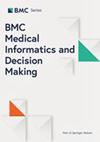摘要
背景:心脏瓣膜手术后肺部并发症(PPCs)具有发病率高、死亡率高和经济成本高的特点。本研究利用可穿戴技术和机器学习算法在术前识别高危人群,从而提高临床决策水平,减少肺部并发症的发生:方法:一项前瞻性研究于 2021 年 8 月至 2022 年 12 月在四川大学华西医院心血管外科进行。我们对 100 名心脏瓣膜手术患者进行了研究,利用可穿戴技术收集和分析患者入院 24 小时内的夜间生理数据,同时从医院信息系统的电子病历中提取临床数据。我们系统地评估了三种不同的输入类型(生理、临床和两者)和五种分类器(XGB、LR、RF、SVM、KNN),以确定对 PPC 具有较强预测性能的组合。对每个模型都使用了交叉验证递归特征消除法(RFECV)进行特征选择,为每个模型选择了一个最佳特征子集,然后使用网格搜索来调整超参数。分层 5 倍交叉验证用于评估泛化性能。使用 DeLong 检验来测试模型间 AUC 差异的显著性,以全面确定最佳预后模型。此外,还对表现最佳模型的特征进行了单变量逻辑回归分析,以了解单个特征对 PPCs 的影响:在这项研究中,22 名患者(22%)出现了 PPCs。在所有分类器中,结合生理和临床特征的模型比单独的生理或临床特征表现更好。具体来说,与仅使用临床数据相比,将生理数据纳入分类模型可提高 AUC、ACC、F1 和精确度,平均提高 8.32%、1.80%、3.28% 和 6.06%。使用这两个数据集的 XGB 分类器性能最高,AUC 为 0.82(± 0.08),并识别出 8 个重要特征。DeLong 检验表明,利用这两个数据集的 XGB 模型明显优于仅利用生理或临床数据集训练的 XGB 模型。单变量逻辑回归分析表明,手术方法、年龄、nni_50 和 min_ven_in_mean 与 PPCs 的发生显著相关:结论:连续可穿戴生理数据和临床数据的整合大大改善了 PPCs 的术前风险评估,有助于优化手术管理并降低 PPCs 的发病率和死亡率。Background: Postoperative pulmonary complications (PPCs) following cardiac valvular surgery are characterized by high morbidity, mortality, and economic cost. This study leverages wearable technology and machine learning algorithms to preoperatively identify high-risk individuals, thereby enhancing clinical decision-making for the mitigation of PPCs.
Methods: A prospective study was conducted at the Department of Cardiovascular Surgery of West China Hospital, Sichuan University, from August 2021 to December 2022. We examined 100 cardiac valvular surgery patients, where wearable technology was utilized to collect and analyze nocturnal physiological data at the 24-hour admission, in conjunction with clinical data extraction from the Hospital Information System's electronic records. We systematically evaluated three different input types (physiological, clinical, and both) and five classifiers (XGB, LR, RF, SVM, KNN) to identify the combination with strong predictive performance for PPCs. Feature selection was conducted using Recursive Feature Elimination with Cross-Validated (RFECV) for each model, yielding an optimal feature subset for each, followed by a grid search to tune hyperparameters. Stratified 5-fold cross-validation was used to evaluate the generalization performance. The significance of AUC differences between models was tested using the DeLong test to determine the optimal prognostic model comprehensively. Additionally, univariate logistic regression analysis was conducted on the features of the best-performing model to understand the impact of individual feature on PPCs.
Results: In this study, 22 patients (22%) developed PPCs. Across classifiers, models combining both physiological and clinical features performed better than physiological or clinical features alone. Specifically, including physiological data in the classification model improved AUC, ACC, F1, and precision by an average of 8.32%, 1.80%, 3.28% and 6.06% compared to using clinical data only. The XGB classifier, utilizing both dataset, achieved the highest performance with an AUC of 0.82 (± 0.08) and identified eight significant features. The DeLong test indicated that the XGB model utilizing the both dataset significantly outperformed the XGB models trained on the physiological or clinical datasets alone. Univariate logistic regression analysis suggested that surgical methods, age, nni_50, and min_ven_in_mean are significantly associated with the occurrence of PPCs.
Conclusion: The integration of continuous wearable physiological and clinical data significantly improves preoperative risk assessment for PPCs, which helps to optimize surgical management and reduce PPCs morbidity and mortality.

 求助内容:
求助内容: 应助结果提醒方式:
应助结果提醒方式:


